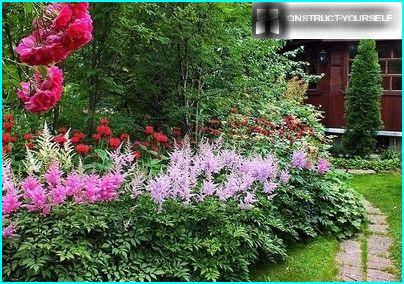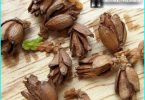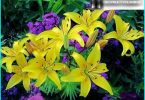The contents
Astilba in natural conditions it grows in deciduous forests of North America and East Asia that are characterized by humid climate.
Astilba – favorite shady gardens, decorated with spectacular inflorescences collected from many openwork flowers purple, lilac, pink and white shades
The plant has erect stems are thin, the height of which depending on species can reach half a meter and above.
Rhizome woody plants annually form a new kidney from which spring the stems grow, and with the onset of cold weather die off. The annual growth of the rhizome about 5 cm In the fall every time developed over the summer and exposed roots sprinkled with fertile soil.
The stems of perennial decorated with graceful pinnate, lobed or long-petiolate leaves are dark green. A complete picture of the terminal inflorescence pyramidal, paniculate or diamond shape, pleasing flowering season for 25-40 days. After flowering gathered in panicles, flowers form the fruit-capsule, filled with small seeds.
Astilbe in garden design
In landscape design astilba in use since the beginning of the XX century. With a variety of shapes and rich colour palette of blooms designers with its help bring to life the most daring ideas.
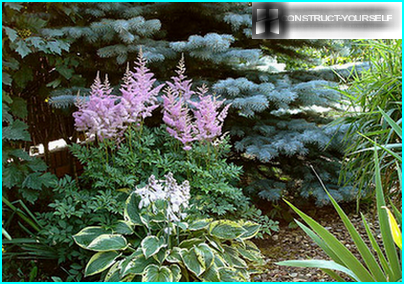
Bushes astilbe appropriate to look at the background of picturesque rockeries or group planting conifers with their rich green needle foliage
Landscaping astilbe often include in the design of artificial water reservoirs, planting perennial as a frame source. A worthy addition to the scenic area there may be bells, plant, daylilies.
It looks harmoniously and in floral arrangements. A good neighborhood can be obtained by planting near astilbe shade-loving ferns and Hosta. Dwarf varieties of this flowering perennial are a real decoration of small shady flower bed. In the spring, while on astilbe have not yet blossomed leaves empty space around it in a flower bed can be filled miniature crocuses and snowdrops.
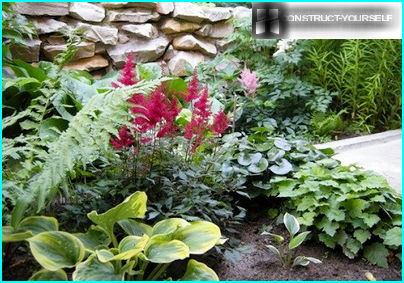
To balance the delicate foliage of perennial help plants with large thick leaves: the host, rodgersia, Badan, cuff, Solomon’s seal, lilies of the valley, hellebore
One of the reasons for the popularity of astilbe is its ability to get along in the shade of the trees. Feeling comfortable even in the conditions of shading, it never ceases to delight with colorful blooms. In a cut fine inflorescence astilbe used in the arrangement of bouquets and to create floral arrangements.
Popular varieties astilby
In ornamental horticulture, there are about two hundred varieties astilby created on the basis of a dozen species. The most popular hybrid groups are: Japanese astilba, Arends, prostrata and Chinese.
Japonica Hybrida
Hybrids Japanese astilbe have a height of 40-80 cm Stalks are decorated with foliage with a pronounced ornament, the color of which varies from pale green to reddish-brown. Dense inflorescence diamond shape painted in crimson, red and white shades.
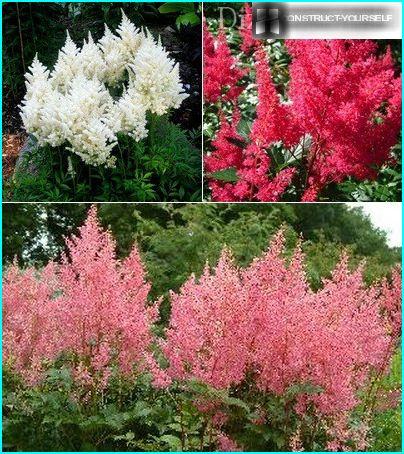
The most famous varieties: «Montgomery» with Burgundy buds, «Rheinland» with panicles of pink-salmon hue, «Deutschland» white air buds
Dense inflorescence of plants in this group bloom much earlier than other varieties. Even after drying, they remain decorative, beautifying the flower garden until the onset of winter.
Arendsii Hybrida
The species is named after its Creator, breeder G. Arends, and are 40 varieties. Height medium crop reaches to 0.6-1 m. Stems adorned with dark green foliage with Burgundy edging, having a spherical or conical shape, and showy inflorescences of creamy-white, yellow and pink shades.
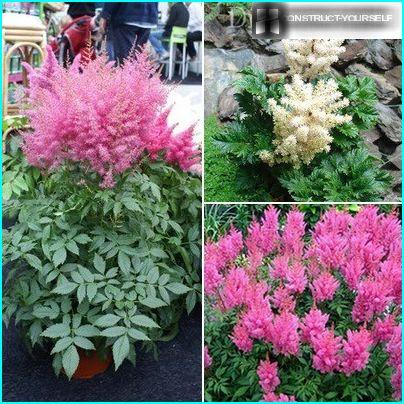
The most decorative are different varieties: «Boogie Woogie» with pink flowers diamond shape, «Gloria» with Lacy foliage and fluffy pink panicles, dwarf perennial «Midget» with clusters of pinkish-salmon hue
Stilbe simplicifolia
Prostrata astilba not tolerate the arid climate. She is of pale green undivided leaves with a glossy surface and unusual pyramidal inflorescences, resembling drooping panicles.
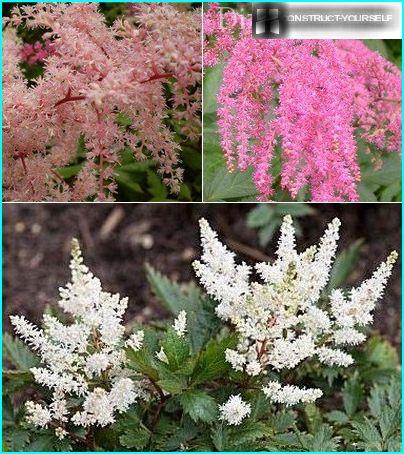
The most beautiful varieties of this group: «Bronze Elegans» with pale bronze buds, «Straussenfeder» with bright coral flowers, «Praecox Alba» lush white «candles»
Astilbe Chinensis
Chinese astilba has a powerful rhizome, which grows displaces its neighboring plants. Stems perennial, height not exceeding 110 cm, decorated with openwork foliage, framed by a thin Golden hairs, and dense inflorescences of white, lilac and pink colors.
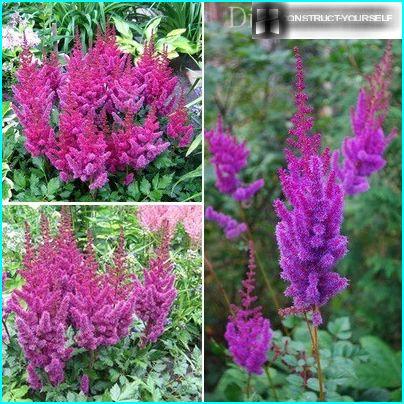
Considered to be the most beautiful varieties: «Vision in Red» with bronze-green foliage and purple-red flowers, «Vision in Pink» with blue-green foliage and light pink panicles, «Purpurlanze» with purple flowers on reddish stems
To decorate the suburban areas it is better to choose medium-grade culture. They are more resistant to adverse climatic conditions.
Numerous cultural varieties of conventionally divided into:
- Dwarf – up to 30 cm.
- Low-growing to 60 cm.
- Medium – up to 90 cm.
- Tall – up to five feet.
Different varieties of this perennial have different flowering periods: early encouraging flowering in early June, medium hybrids put bright accents in mid-summer, and late-decorate the garden variegated «torches» towards the end of the season.
Methods of breeding of perennial
In one place the shrub can grow up to five years, after which it is required to rejuvenate. Propagated perennial, early spring and late autumn, using seed or vegetative method.
Method #1 — vegetative
This method involves dividing the rhizomes in 2-3 parts, each of which has a withered stem with dormant buds. When propagated vegetatively, astilbe can be planted at any time. The main thing is to provide in the first days after transplantation of a sufficient amount of moisture.
Good catch on the bushes and in the flowering period, subject to the same humidity conditions.
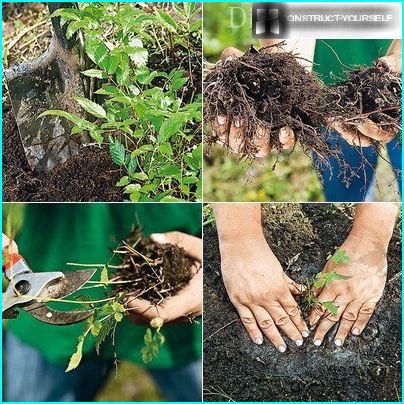
In vegetative way woody rhizome is dug from the earth, washed in water and using secateurs or shovels cut into several sections
The rhizome should be divided so that each cut plot was left for 2-3 replacement buds at the base, which later will go shoots.
The size of the plots is not significant enough and the rhizome length of 3-5 cm They are planted at a distance of 30 cm from each other. The next season planted plots are active in the growth and spread of lush panicles.
Method #2 — seed
This method is quite time-consuming, but it allows you to display new growth. Collect seeds from the plants in early September, neatly cutting off the blossoms and bolls. They spread on the paper and leave in a warm place for two weeks. To get the smallest peas enough to shake the dried panicles. Collected seeds are placed in a bag and leave till spring.
When growing astilbe from seed planting materials are sown in February — March in the tank, filled with a mixture of peat and sand, taken in the ratio 3:1.
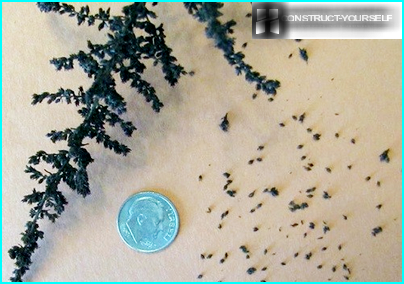
Seeds from astilbe very small and they germinate quite slowly, so tentatively it is desirable to subject stratification
Seeds are dispersed on the surface of moist soil and cover with glass or plastic wrap. At this stage it is important to observe and humidity conditions, keeping the soil dry. Some growers recommend for this use «snow» out of the freezer, which melts gradually moisten the soil.
The first seedlings appear after 3-4 weeks, but only at the end of the season they form small rosettes of leaves. To water tender seedlings very carefully, directing a thin jet of water at the root.
If the young bushes in the greenhouse do not jostle each other, they can not disturb until the following spring. Grown from seed the shrub will delight flowering in the third year of planting.
Rules landing astilbe
Best of all, this culture is growing in the loose and slightly acidic soils. To lower the acidity to the required level at 5.5-6.5 pH is possible by making when digging wood ash or dolomite.
Astilba prefers shaded areas, located a short distance from the spreading crowns of the trees. The best option is the sparse shade.
When choosing where you should focus on the timing of flowering. Early and late varieties can be placed in open areas and in partial shade. Srednebelaya better to plant in shaded corners, as the scorching July sun significantly reduces the time of their flowering.
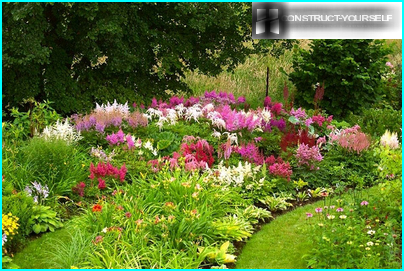
Perennial, preferably placed so that in all its glory appeared not only delicate blossoms, but opened eyes its graceful leaves
Astilbe inherently hydrophilic. Most varieties feel comfortable in marshy ground, quietly transferring the stagnant water.
The planting hole is half filled with compost, which is thoroughly mixed with the soil. It is useful and organic fertilizers, taking them at the rate of 2 buckets manure per 1 sqm fertilizers. Enriched ground water. Waiting until she is fully absorbed, plant your tree and sprinkled it with earth so that the layer thickness on the residual kidney was about 4 cm the soil around the stem seal and to avoid formation of aerial niches in the soil re-watered.
Recommendations and secrets of nursing
To minimize the care of this blossoming culture, it is enough to observe some simple guidelines:
- During the vegetative period to feed complex fertilizers. To provide a root layer of soil the necessary amount of nitrogen, potassium and phosphorus can when digging in the spring, making of calculation 30g/sq. m. In mid-July, feed potassium nitrate (2 tbsp per 10 liters of water) and the last feeding after flowering superphosphate, dividing it by 20 g per Bush.
- To make timely watering. Water-loving plant does not tolerate long-term drought. On hot summer days, it needs to be watered up to two times a day. Particularly in need of culture in emergency watering during the formation of inflorescences. Pour the astilba better in the early morning and after sunset.
- To mulch the soil. To maintain the looseness of the soil and reduce the loss of moisture will help mulching the planting area with wood bark or shavings. Mulch will prevent the overheating of the earth in the summer and the roots freezing in the winter months.
- Every five years to rejuvenate the Bush. The ability of rhizomes to quickly build mass requires periodic rejuvenation of the Bush. At the end of each season of exposed rhizomes be sure to sprinkle fresh soil. Otherwise vipereye old roots young shoots are bare and dry, which in turn negatively affects the quality and duration of flowering.
- To fight pests. Nematode and drooling pennica – the main pests of the plant. They hit the leaves and rhizomes of the plant, causing its wilting and death. To get rid of nematodes can only be completely destroying the affected instance. With pennica a little easier. The larvae you can try to destroy by mechanical means without damaging the roots and stems, or applying garden chemicals: konfidor, the Akhtar, Malathion.
- After flowering, trim the stems. But some gardeners, on the contrary, leave the dried flower stalks are not cut to those as long as possible was decorated with spring garden.
- Shelter plant in the winter. In winters the bulk of the varieties of this flowering of culture freeze slightly. To warn before the onset of cold weather, the stems are cut to ground level, mulch the exposed roots with peat and cover with fir twigs.
In the future, fledgling plant weed control will be to do yourself – its powerful roots an excellent job with this task.
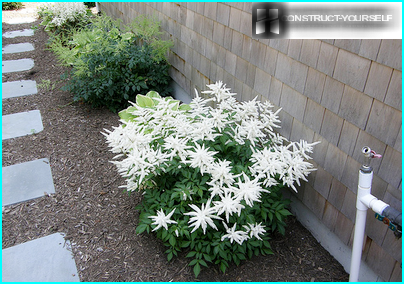
To weed this dank beauty only in the beginning of its growth at the stage of building of roots and green mass
Finally, we offer you to watch an interesting video about autumn pruning astilbe:

